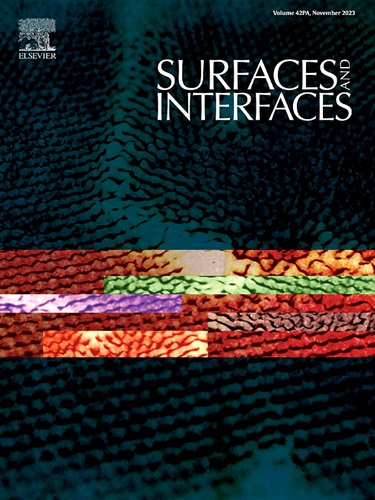Liquid AlCoCrFeNi and AlCoCrFeNiX (X = Mo, Ta) high-entropy alloys on graphite: Wetting, reactivity and CALPHAD modelling
IF 5.7
2区 材料科学
Q2 CHEMISTRY, PHYSICAL
引用次数: 0
Abstract
Wettability and interfacial reactivity with graphite of three equimolar High-Entropy Alloys (HEAs), namely AlCoCrFeNi (HEA-base), AlCoCrFeNiMo (HEA-Mo) and AlCoCrFeNiTa (HEA-Ta), were investigated for the first time, aiming to support industrial sectors involving liquid-phase processing routes. Isothermal high-temperature wettability tests were performed at 1400 °C for HEA-base and HEA-Mo, and at 1580 °C for HEA-Ta. The samples were then analysed by SEM-EDS. Based on the in-house-built GHEA thermodynamic database, CALPHAD calculations were used to simulate and discuss liquid-solid interactions occurring at high temperatures as well as transformations taking place in the samples during cooling. HEA-base wetted the graphite well after 5 min and the wetting behaviour significantly improved for HEA-Mo after the same contact time. HEA-Ta, after initial melting and wetting stage, solidified due to high-melting phases formation. All the graphite/HEA samples formed refractory carbides. For HEA-base and HEA-Mo, such carbides were found homogeneously dispersed in the whole drop. In HEA-Ta, TaC formed a compact layer separating two liquids of different compositions, with only one of these being in contact with the graphite substrate. The here proposed combination of experiments and thermodynamic calculations allowed to understand and discuss both high-temperature reactivity and evolution of the systems over cooling. Overall, a remarkable agreement between equilibrium calculations and experimental findings was observed for these complex dynamic systems.

石墨上的液态 AlCoCrFeNi 和 AlCoCrFeNiX(X = Mo、Ta)高熵合金:润湿性、反应性和 CALPHAD 建模
首次研究了三种等摩尔高熵合金(HEA),即 AlCoCrFeNi(HEA-base)、AlCoCrFeNiMo(HEA-Mo)和 AlCoCrFeNiTa(HEA-Ta)的润湿性以及与石墨的界面反应性,旨在为涉及液相加工路线的工业部门提供支持。对 HEA 碱和 HEA-Mo 进行了 1400 ℃ 等温高温润湿性测试,对 HEA-Ta 进行了 1580 ℃ 等温高温润湿性测试。然后对样品进行了扫描电镜-电子显微镜分析。根据内部建立的 GHEA 热力学数据库,使用 CALPHAD 计算来模拟和讨论高温下发生的液固相互作用以及样品在冷却过程中发生的转变。5 分钟后,HEA-base 能很好地润湿石墨,在相同的接触时间后,HEA-Mo 的润湿性能明显改善。HEA-Ta 在经过最初的熔化和润湿阶段后,由于高熔相的形成而凝固。所有石墨/HEA 样品都形成了难熔碳化物。在 HEA-base 和 HEA-Mo 样品中,这些碳化物均匀地分散在整个液滴中。在 HEA-Ta 中,TaC 形成了一个紧密的层,将两种不同成分的液体隔开,其中只有一种液体与石墨基底接触。实验和热力学计算的结合有助于了解和讨论高温反应性和系统在冷却过程中的演变。总之,在这些复杂的动态系统中,平衡计算与实验结果之间存在着显著的一致性。
本文章由计算机程序翻译,如有差异,请以英文原文为准。
求助全文
约1分钟内获得全文
求助全文
来源期刊

Surfaces and Interfaces
Chemistry-General Chemistry
CiteScore
8.50
自引率
6.50%
发文量
753
审稿时长
35 days
期刊介绍:
The aim of the journal is to provide a respectful outlet for ''sound science'' papers in all research areas on surfaces and interfaces. We define sound science papers as papers that describe new and well-executed research, but that do not necessarily provide brand new insights or are merely a description of research results.
Surfaces and Interfaces publishes research papers in all fields of surface science which may not always find the right home on first submission to our Elsevier sister journals (Applied Surface, Surface and Coatings Technology, Thin Solid Films)
 求助内容:
求助内容: 应助结果提醒方式:
应助结果提醒方式:


